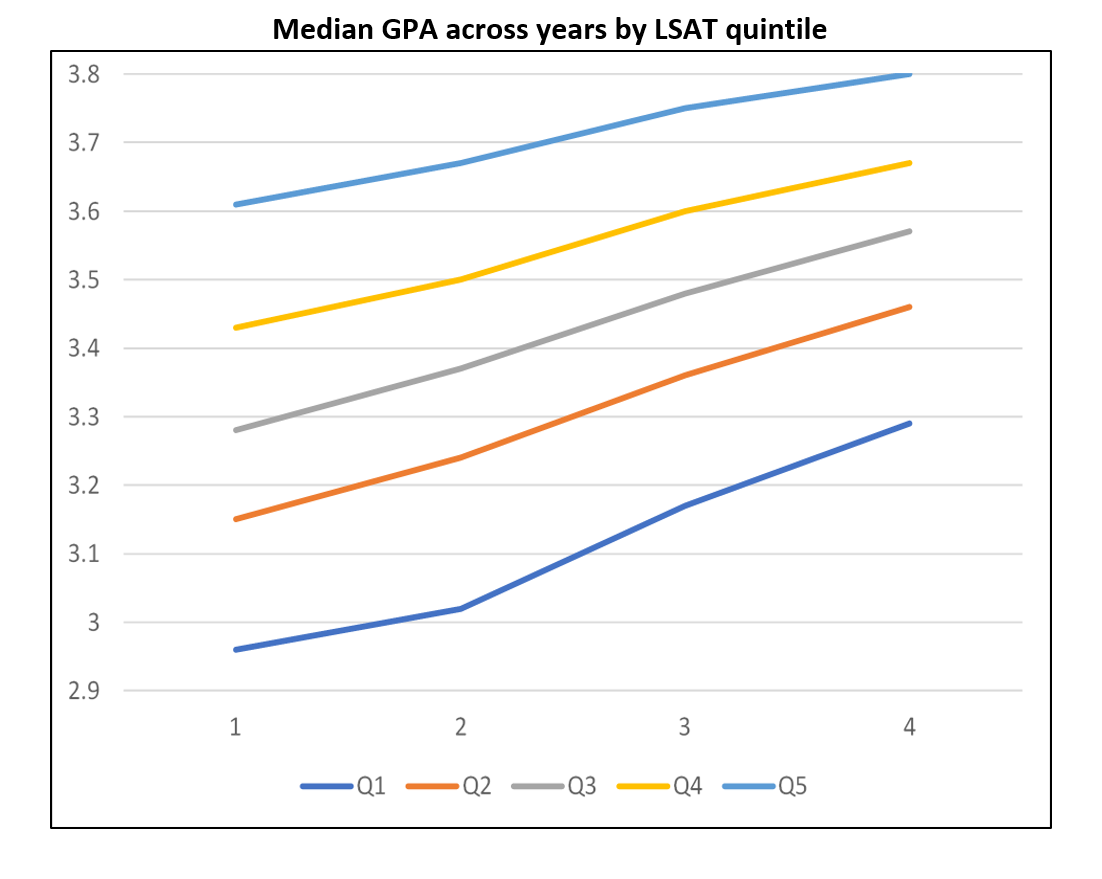Changes in Undergraduate Grade Point Averages Across Years of School (RR 20-01)
Contextual Information for Holistic Evaluation in Law School Admission
The figure below shows the progression of undergraduate yearly grade-point average (GPA) for law school applicants across 4 years of undergraduate study divided into quintiles based on individual Law School Admission Test (LSAT) scores. The dark blue line represents 4 years of median GPA for applicants scoring in the lowest quintile or score band (120-147), the red line represents the second quintile (148-152), the gray line represents the third quintile (153-157), and so forth. As the chart shows, the increase in GPA from year 3 to year 4 is steeper for the lowest scoring groups.
Figure 1: Median GPA across years by LSAT quintile

Because a standardized score scale is used for all takers of the LSAT, the LSAT’s use as an interpretive tool avoids problems that would be encountered when attempting to incorporate information based on undergraduate or graduate programs due to their heterogeneity in terms of selectivity, grading standards, course requirements, and so forth. A recent survey of law school faculty teaching required courses found that all of the top skills identified by faculty as highly important are measured by the LSAT today. This research was part of LSAC’s ongoing improvement to the LSAT to ensure it remains the best cognitive indicator of prospective students’ potential for success in law school.
A full set of trends by different demographic groupings is provided in the full report for a better contextual understanding of GPA growth. However, using quintiles of LSAT performance provides a pragmatic understanding of trends. This strategy helps to protect against the false implication that grades can be attributed to personal characteristics, such as race or gender, rather than to student learning and engagement.
The recommendation to use the LSAT quintile chart as an interpretive tool is not intended to provide numeric adjustments to cumulative undergraduate grade-point averages (UGPA) for individual students. The trend line suggests only a general relationship that should be taken into consideration in the context of multiple indicators. This is consistent with LSAC policy (PDF) on the use of the LSAT as one of multiple indicators for the purpose of admission to law school.
It is also important to keep in mind issues regarding the option of Pass/Fail grades. Because institutions may use different variations of the general policy and the impact on students is likely to depend on a number of personal factors, a one-size-fits-all adjustment is ill-advised. Students have experienced disruptions during the COVID-19 crisis due to instructional support, emotional distress, or even physical health and safety. The Pass/Fail policies are intended to at least in part ameliorate these sources of harm.
The interpretative guides we offer are also intended to offset the unprecedented uncertainties in student evaluation relative to UGPA. However, both the use of Pass/Fail grades by undergraduate institutions and our interpretive guide should be seen as complementary efforts to promote an accurate, holistic evaluation of students’ applications. In conjunction with other sources of information on student qualifications, this process can be tailored to provide a fair evaluation of individual applicants.
Some further takeaways:
- Applicants generally have higher grades near the end of their undergraduate studies, and the decision to use Pass/Fail could disadvantage some students who were counting on those grades to raise their undergraduate GPA. This may be a source of frustration or stress to those students. Our research suggests that admission officers should be sensitive to the possibility that UGPAs were negatively impacted.
- Providing students with grade-optional policies may positively impact Spring 2020 grades in some cases due to students applying the policy selectively. Because some students may be negatively impacted for other reasons, a numerical adjustment to UGPA is impractical. No algorithm can be expected to properly weight all the relevant factors.
- Personal considerations are important when evaluating UGPA. All students are affected by personal factors, but marginalized populations may be particularly vulnerable in Spring 2020. These considerations include:
- Variations in access to computer or technology resources, suitable study environments, and personal circumstances (lack of childcare, illness, personal or parental job loss, general anxiety and stress).
- Decisions about taking Pass/Fail grades or letter grades, even for individuals from the same school, may vary by subgroup and personal circumstances.
- Involuntary online learning may vary in effectiveness — some students learn and perform better in face-to-face settings. Arrangements for students needing accommodations offered by schools may not have been available or may have been less effective.
For more information about the progression of undergraduate GPAs among law school applicants, please download the full report today.


